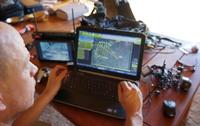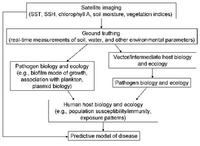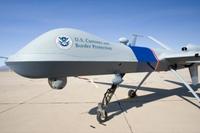-
Terrorists develop tactics to evade U.S. drones
The CIA’s use of Predator drones against Islamic militants in the Middle East began shortly after the 9/11 attacks and has increased dramatically during the Obama administration. As the number of drone strikes in Yemen increased, AQAP militants began to develop tactics to hide themselves from a drone’s sensors.
-
-
DHS IG questions value of CBP’s border drone program
DHS’s 8-years-old drone program, now consisting of nine drones operating in Arizona, Texas, and North Dakota, has been unsuccessful, according to a just-released DHS inspector general report. Customs and Border Patrol(CBP) expected 23,000 total flight hours per year, but it only logged about 5,100 in fiscal year 2013. The inspector general’s report notes that drones helped in less than 2 percent of apprehensions of illegal immigrants.CBP has used the dronesto cover just 170 miles of the U.S. border – and a 2014 GAO report noted that a fifth of CBP drone flights were conducted within the interior of the United States and beyond the 100-mile range of operations of CBP jurisdiction points.
-
-
Speedy, agile UAVs for troops in urban missions
DARPA aims to give small unmanned aerial vehicles (UAVs) advanced perception and autonomy rapidly to search buildings or other cluttered environments without teleoperation. The program aims to develop and demonstrate autonomous UAVs small enough to fit through an open window and able to fly at speeds up to twenty meters per second (45 miles per hour) — while navigating within complex indoor spaces independent of communication with outside operators or sensors and without reliance on GPS waypoints.
-
-
Public support for torture declines as people learn the explicit details of torture techniques
Does the American public condone torture when the goal is to prevent terrorist attacks? News headlines reporting the results of a Pew Research Center poll released on 9 December indicate more than half of Americans do. That finding, however, is not necessarily valid, says Tufts University’s Richard Eichenberg, who argues that the poll is flawed because it is based on a faulty premise. A more accurate picture of the nation’s attitude can be found in responses to polls conducted by Pew, Gallup, and other news organizations and analyzed in a 2010 report. These surveys explained in graphic detail what interrogation techniques were being judged. So while response to more general questions on the use of torture may continue to produce mixed reactions, Eichenberg says public support for torture will decline as more people become aware of the explicit details of torture techniques contained in the Senate report.
-
-
FAA would allow four private companies to operate drones in U.S. airspace
The Federal Aviation Administration(FAA) announced the other day that it would allow four private companies to operate drones in U.S. airspace. The drones will be used to survey land, inspect remote oil rigs, perform agricultural and environmental research, monitor construction projects, and collect geographical data. The FAA has banned most drone flights as they pose a risk to the safety of manned aircrafts, and in some cases to privacy. The drone industry says that if drones are integrated into U.S. civilian airspace, the domestic economic impact would surpass $82.1 billion between 2015 and 2025, while creating more than 100,000 high-paying jobs.
-
-
University of Maryland opens new drone test facility

The University of Maryland has recently opened a new drone test site on the Eastern Shore which will allow researchers and students to help in the safe development of drones for use in U.S. airspace. The university will partner with companies to develop projects in a safe space. Already there are plans to use drones to monitor fish populations in the nearby Chesapeake Bay, examine power lines in the southern part of the state, and perform jobs which are considered “dirty, dull [or] dangerous,” in the words of the head of the facility.
-
-
DOJ’s new cyber unit to provide legal guidance on electronic surveillance
The Justice Department is creating a cybersecurity unit within its Computer Crime & Intellectual Property Section (CCIPS) to provide legal guidance on electronic surveillance investigations.The unit will also work with Congress on cybersecurity legislation and focus on cybercrime prevention.
-
-
Smaller lidars could be mounted on UAVs for underwater scans

Bathymetric lidars — devices which employ powerful lasers to scan beneath the water’s surface — are used today primarily to map coastal waters. At nearly 600 pounds, the systems are large and heavy, and they require costly, piloted aircraft to carry them. Georgia Tech Research Institute (GTRI) researchers have designed a new approach that could lead to bathymetric lidars that are much smaller and more efficient than the current full-size systems. The new technology would let modest-sized unmanned aerial vehicles (UAVs) carry bathymetric lidars, lowering costs substantially. These advanced capabilities could support a range of military uses such as anti-mine and anti-submarine intelligence and nautical charting, as well as civilian mapping tasks. In addition, the new lidar could probe forested areas to detect objects under thick canopies.
-
-
Satellites help assess risk of epidemics

Changes in the environment, global trade, and travel are all factors in the ever-increasing numbers and movement of pests. Identifying and predicting the distribution of existing local species as well as the spread of new exotic ones are essential in assessing the risk of potential epidemics. Researchers have developed Vecmap — an all-encompassing software and services package including a smartphone app for field studies with a time and location information system, all linked to an online database. The database pools satellite information with results from field research, and satnav adds location information. The new approach greatly reduces the complexity of tracking species compared to traditional methods.
-
-
A malware more sophisticated than Stuxnet discovered
Security experts at Symantechave discovered the world’s most sophisticated computer malware, Regin. Thought to have been created by a Western intelligence agency, and in many respects more advanced than Stuxnet — which was developed by the U.S. and Israeli government in 2010 to hack the Iranian nuclear program — Regin has targeted Russian, Saudi Arabian, Mexican, Irish, and Iranian Internet service providers and telecoms companies. “Nothing else comes close to this … nothing else we look at compares,” said one security expert.
-
-
GOP senators block NSA surveillance reform bill
The USA Freedom Act, a bill introduced last year aiming to curtail some of the NSA’s data collection programs, especially those focusing on U.S. phone data, failed last night to reach the 60-vote threshold required to cut off debate and move to a vote. Senator Mitch McConnell (R-Kentucky), the Republican leader, and other leading GOP senators worked hard to defeat the bill. Nearly a year-and-a-half after the Edward Snowden’s revelations, the act was considered the most politically viable effort in four decades to place curbs on NSA activities. Civil libertarians and technology companies supported the bill, as did the White House and the intelligence community – although the latter two did so more out of fear that a failure of the bill would jeopardize the extension of Section 215 of the Patriot Act, which expires next June.
-
-
Drones watch over U.S. borders

Since 2000, the number of Border Patrol agents on the 1,954-mile U.S.-Mexico border has more than doubled, to surpass 18,000, and fencing has increased nine times — to 700 miles. Some members of Congress and border state lawmakers are calling for more border agents and more fencing, but the Obama administration is looking to drones to help reduce the number of illegal immigrants and drugs entering the United States, while simultaneously shifting resources and agents to parts of the border where illegal activity is highest.
-
-
FBI: Lawmakers should mandate surveillance “backdoors” in apps, operating systems
FBI director James Comey said that the agency was pushing lawmakers to mandate surveillance functions in apps, operating systems, and networks, arguing that privacy and encryption prevent or disrupt some of the agency’s investigations. According to Comey, new privacy features implemented by Google and Apple in the wake of the Snowden revelations, automatically encrypt user communication and data, making it difficult for law enforcement to gather evidence and connect links among suspected criminals and terrorists.
-
-
Judges question claims that NSA metadata collection poses threat to ordinary citizens
A panel of three judges on the U.S. Court of Appeals for the District of Columbia challenged arguments made earlier this week by Larry Klayman, a conservative lawyer arguing on his own behalf, and Cindy Cohn, an attorney representing the Electronic Frontier Foundation (EFF) and the American Civil Liberties Union (ACLU), that the National Security Agency’s (NSA) mass-surveillance program is a breach of the Fourth Amendment, which protects against unreasonable searches.The case, Klayman v. Obama, is one of three currently at the appeals-court level regarding the NSA surveillance program.In the D.C. Circuit Court of Appeals, Judges Stephen Williams and David Sentelle voiced skepticism about claims that collecting metadata posed a threat to ordinary citizens.
-
-
ICE offices subscribed to national license-plate database in violation of DHS policy
In February, DHS officials dropped a controversial bidwhich would have allowed the department to access a national license-plate database, citing possible violation of Americans’ civil liberties. Soon after, DHS officials established a policy which required similar plans to be reviewed by department privacy officers. Roughly two months after that policy was put in place, officials with DHS’s Newark and Houston field offices of the Immigration and Customs Enforcement(ICE) agency purchased subscriptions for a commercially run national license-plate database without approval from DHS’ privacy office.
-
- All
- Regional
- Water
- Biometrics
- Borders/Immig
- Business
- Cybersecurity
- Detection
- Disasters
- Government
- Infrastructure
- International
- Public health
- Public Safety
- Communication interoperabillity
- Emergency services
- Emergency medical services
- Fire
- First response
- IEDs
- Law Enforcement
- Law Enforcement Technology
- Military technology
- Nonlethal weapons
- Nuclear weapons
- Personal protection equipment
- Police
- Notification /alert systems
- Situational awareness
- Weapons systems
- Sci-Tech
- Sector Reports
- Surveillance
- Transportation
Advertising & Marketing: advertise@newswirepubs.com
Editorial: editor@newswirepubs.com
General: info@newswirepubs.com
2010-2011 © News Wire Publications, LLC News Wire Publications, LLC
220 Old Country Road | Suite 200 | Mineola | New York | 11501
Permissions and Policies
Editorial: editor@newswirepubs.com
General: info@newswirepubs.com
2010-2011 © News Wire Publications, LLC News Wire Publications, LLC
220 Old Country Road | Suite 200 | Mineola | New York | 11501
Permissions and Policies
